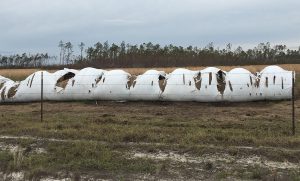GAINESVILLE, Fla. — In the days after Hurricane Michael swept through the Florida Panhandle last October, residents assessed the damage while relief workers and aid traveled into the area to start the recovery process.

For cattle ranchers, some of the immediate relief came in the form of fallen tree removal, fence rebuilding and a donated ryegrass seed developed by University of Florida Institute of Food and Agricultural Sciences researchers.
FrostProof ryegrass was bred in a decade-long process to produce a high-yielding forage for livestock while also being disease-resistant and cold-tolerant, said Kevin Kenworthy, a professor with the UF/IFAS agronomy department and leader of its annual ryegrass breeding program.
Although FrostProof’s cold hardiness is largely unnecessary for Floridian fields, the seed took quickly to the storm-ravaged land and was fodder-ready within approximately six weeks, said Ann Blount, UF/IFAS forage breeding and management professor at the North Florida Research and Education Center in Quincy, Florida.
“The Florida Cattlemen’s Association came up immediately to help all the livestock producers,” said Blount, who also runs a ranch with her daughter in Gadsden County. “They brought barbed wire, chainsaws, fencing supplies, fuel – all kinds of supplies to help.”
That included coordinating resource donation and delivery through the association’s allied members, like Alabama Farmers Cooperative, Kelly Seed Company, Seminole Feed, Smith Seed Services, Westway Feed Products and others. The Florida Cattlemen’s Association assisted in distributing at least 10 tons of the donated ryegrass seed to ranches throughout the hard-hit Calhoun and Gulf counties.
“When the trees went down in the pastures, people couldn’t plant their pastures for winter grazing,” Blount said. “Most winter forages require a grain drill, except for ryegrass.”
The problem was exacerbated by the rainy summer that preceded the hurricane, Blount added, which prevented ranchers from harvesting good-quality hay. Those who had already prepared silage for the winter saw it ruined in the storm.
“We had hungry cattle eating poisonous weeds, acorns and leaves off of fallen trees,” Blount said. “That little bit of relief given with the ryegrass seed went a long way to help the people that needed it.”
-30-
The mission of the University of Florida Institute of Food and Agricultural Sciences is to develop knowledge relevant to agricultural, human and natural resources and to make that knowledge available to sustain and enhance the quality of human life. With more than a dozen research facilities, 67 county Extension offices, and award-winning students and faculty in the UF College of Agricultural and Life Sciences, UF/IFAS works to bring science-based solutions to the state’s agricultural and natural resources industries, and all Florida residents. Visit the UF/IFAS website at ifas.ufl.edu and follow us on social media at @UF_IFAS.
 0
0
